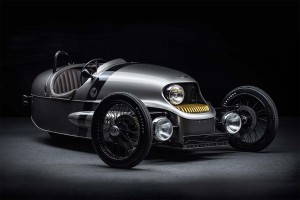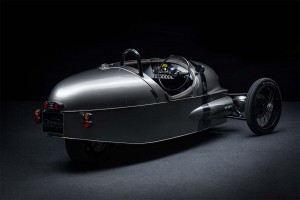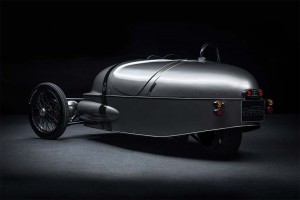It’s hard to find an automaker these days that isn’t going electric – even exotic brands like Aston-Martin, Bentley and Lamborghini. But Morgan?
The tiny British maker has made a handsome business out of being decidedly retro, even retaining the classic wood frames of yesteryear. So, when it unveiled a quirky, three-wheeled EV prototype in 2015 few took it seriously, even when it followed with a more production-ready version at the 2016 Geneva Motor Show.
But the Morgan EV3 is about to become a reality with the help of Frazer-Nash Energy Systems, says Morgan Managing Director Steve Morris. “We have been working closely on optimizing the EV3’s architecture in every way to develop a car which will offer proven reliability range and cooling performance, combined with the pure driving experience that is expected of every hand-crafted Morgan.”
(Honda teases more mainstream, 3rd-gen Insight hybrid. Click Here to check it out.)
Set for production during the third quarter of 2018, the Morgan EV3 has undergone a few changes since the last prototype was revealed. It now features a liquid-cooled, single electric motor making a sustained 34.8kW, or 41.8kW under hard acceleration – which works out to barely 47 horsepower under normal conditions. Not much in a world where sports cars routinely boast 10 times as much. But the decidedly retro, open-top two-seater doesn’t need much, especially considering it weighs in at just under 1,100 pounds.
So, when you account for the fact that electric motors deliver tremendous off-the-line torque, Morgan promises a 0-60 launch in just 7 seconds. That’s down from the original estimate of 9 seconds, but there has been a trade-off, Morgan now estimating range at a modest 120 miles – down from the original 150 using a 21 kilowatt-hour lithium-ion battery back.
Morgan also notes that by mounting the battery pack low it actually will help enhance the handling of the EV3.
(New BMW partnership aims to bring next-gen solid state batteries to market. Click Here for the latest.)
As with all Morgan’s there’s a decidedly historic, almost steam-punk quality to the EV3. It features the sort of large, thin steering wheel that might have been used on the race circuit when sports cars really looked like this. The drive mode switch looks like the armature of an old magneto and there’s plenty of wood and brass. But there’s also a very modern digital display.
The same goes for the body and chassis. The tubular space frame was “inspired by 1930s Aero-engine race cars, classic motorcycles and 1950s fantasy automatons,” the company suggests. And there’s also ash components in the underlying frame. But the Morgan EV3 also blends aluminum and carbon composite body panels.
Though company officials admit it’s going to be a challenge to work the EV3 into their existing assembly plant – where most work continues to be done by hand – they really have no choice.
Increasingly stringent emissions and mileage rules are being put in place worldwide and Norway and India have already announced they will ban the sale of vehicles using internal combustion engines by the end of the coming decade. Great Britain, France and China are considering similar bans, as are the dozen states following California’s tough emissions mandates.
“The EV3 plays an important role in Morgan’s future strategy. Achieving Zero Emissions using electrification is a requirement no manufacturer can afford to ignore,” said Noamaan Siddiqi, Business Development Director, Frazer-Nash Energy Systems. “Morgan has always embraced the latest technology within its vehicles to ensure it can continue to build relevant hand-crafted British sports cars.”
Indeed, Morgan has already announced that by sometime in 2019 it expects to offer hybrid or fully electric versions of all of its products.
It’s not yet clear if the British maker will export the EV3 to the States. Back home, pricing will start at the equivalent of about $40,000.
(Toyota aims to add at least 10 EVs by early 2020s. Click Here for the full story.)




Spelling…
Set for production during the third quarter of 2018, the Morgan EV3 has undergone a DEW…
Thanks for the catch, I will blame my cold meds…
About to fix.
Paul E.